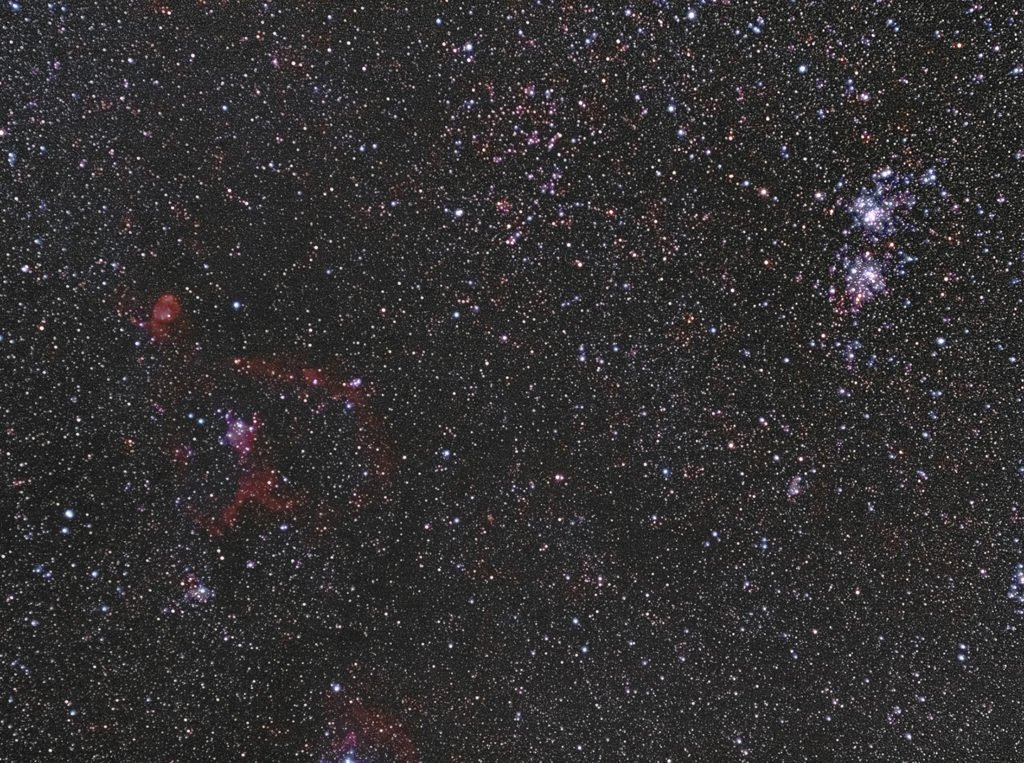With the best budget telescope, you can see the stars and planets without going broke. As we’ll prove in this article, stargazing isn’t just a pastime for professional scientists and rich hobbyists. Everyone can enjoy astronomy from their own backyard.
We have affordable telescopes for adult amateurs. There are telescopes for more tech-savvy users. And we have also included telescopes for curious kids.
The Celestron AstroMaster 130EQ Newtonian Telescope is the best budget telescope. It’s an excellent choice for beginners, being easy to set up and use. But it has the magnification to give you a cosmic stargazing experience. And, like all the telescopes on our list, it has an affordable price tag!
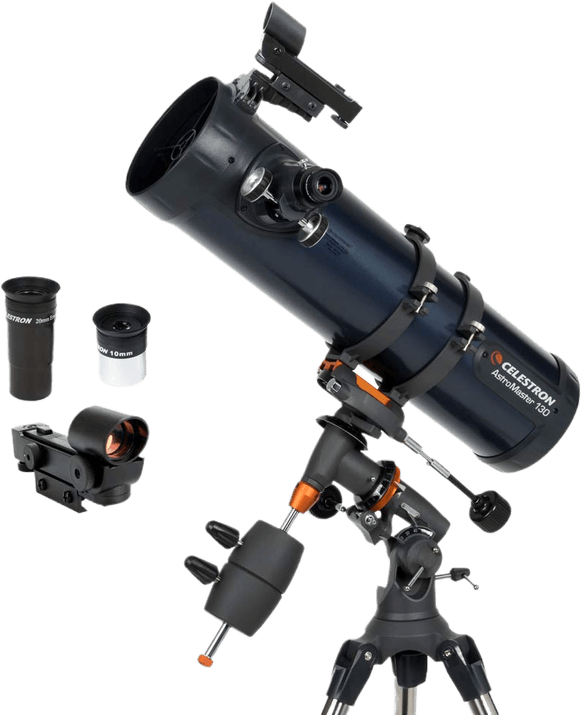
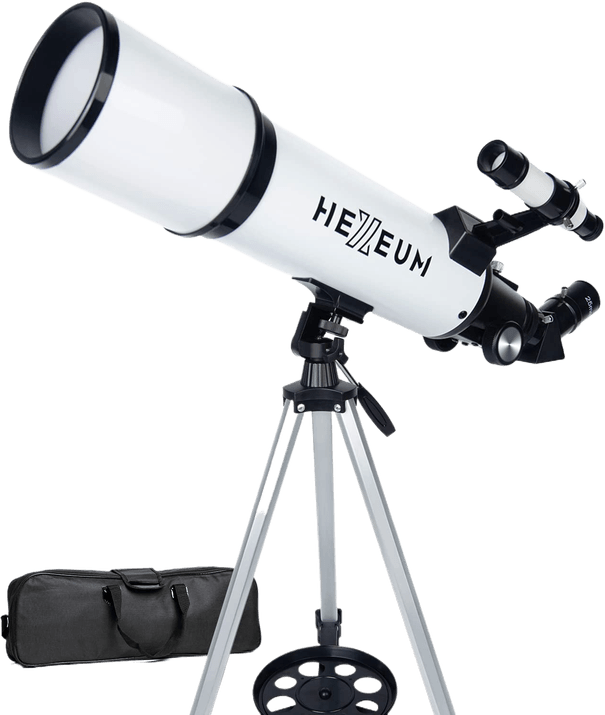
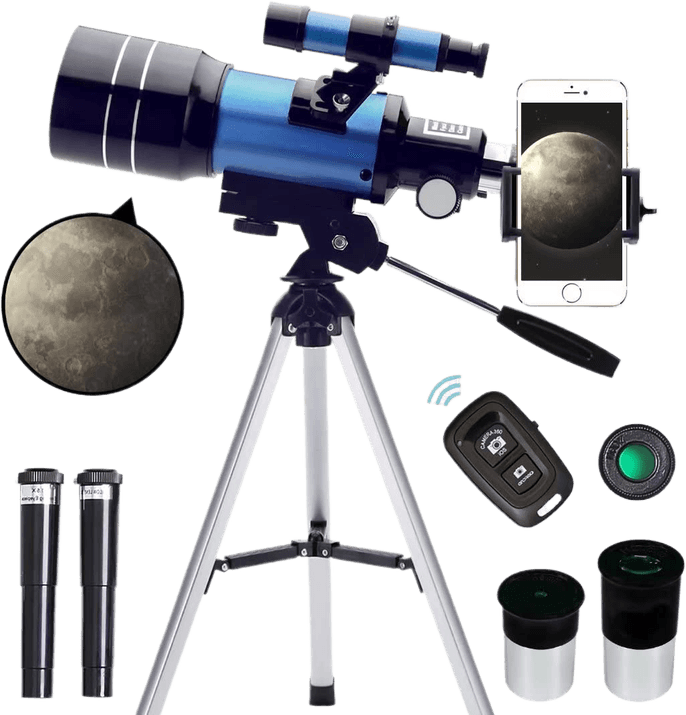
What Is the Best Budget Telescope?
The best budget telescope is affordable but still gives you an incredible glimpse into the cosmos above us. Professional astronomy telescopes cost thousands of dollars. But that doesn’t mean normal people like us can’t look at the stars.
The prices of the telescopes we look at do vary. Some are more affordable than others. But all the telescopes we recommend are below $500 brand new. Some only just come in under that threshold. But others give you plenty of change from your $500 bill. We can look at the stars without remortgaging the house!
As well as price, there are other things you need to look for in a telescope. The optical design is always noteworthy when buying one. As is the eyepiece lens design. There are also specifications like focal length, aperture, and focal ratio.
If you’re unfamiliar with the more technical telescope terminology, we explain at the end of the article. You can skip to the buyer’s guide if you need more information.
If you’re ready to look at telescopes, you can see a quick rundown of the best budget telescopes below. We then look at each telescope in more detail in the following section.

- Ideal for astronomy beginners with user-friendly design
- Celestial and terrestrial objects are clear and bright
- Quick, tool-free setup and sturdy pre-assembled tripod
- Bonus astronomy software for interactive sky simulations

- 3 eyepieces including a 3x Barlow eyepiece
- Focal length f/7.5 gives broad view of night sky
- Smatphone adapter and wireless remote included
- Lightweight and portable with handy carry case

- 2 eyepieces and a Barlow lens for 3x magnification
- Multi-layer high transmission lens coating
- Smartphone adapter for device syncing
- Affordable, lightweight, and easy to set up
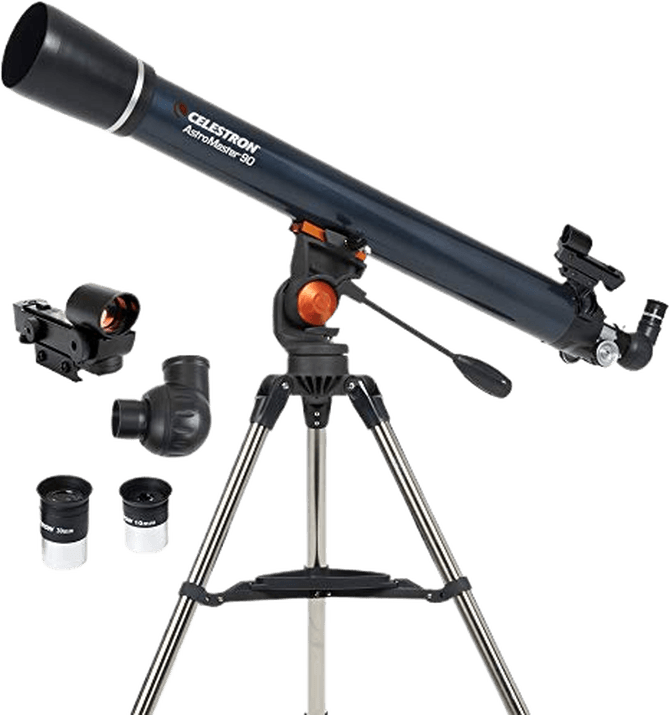
- Comes with 10mm and 20mm eyepieces
- Focal ratio f/11 is perfect for planetary observation
- Altazimuth mount and aluminum tripod
- Glass treated with high transmission coating
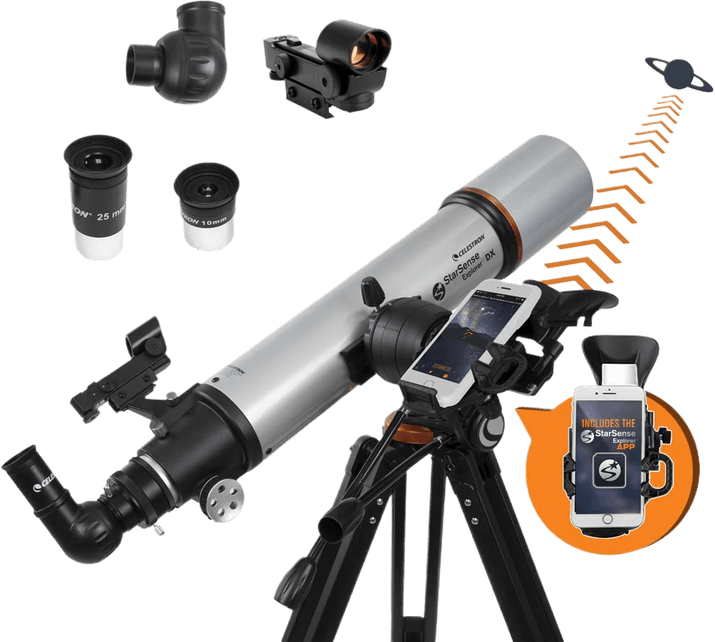
- 10mm and 25mm eyepieces included
- Crystal-clear optics and wide-angle view
- Excellent motion control with dual-axis Altazimuth mount
- Comes with smartphone adapter and StarSense app
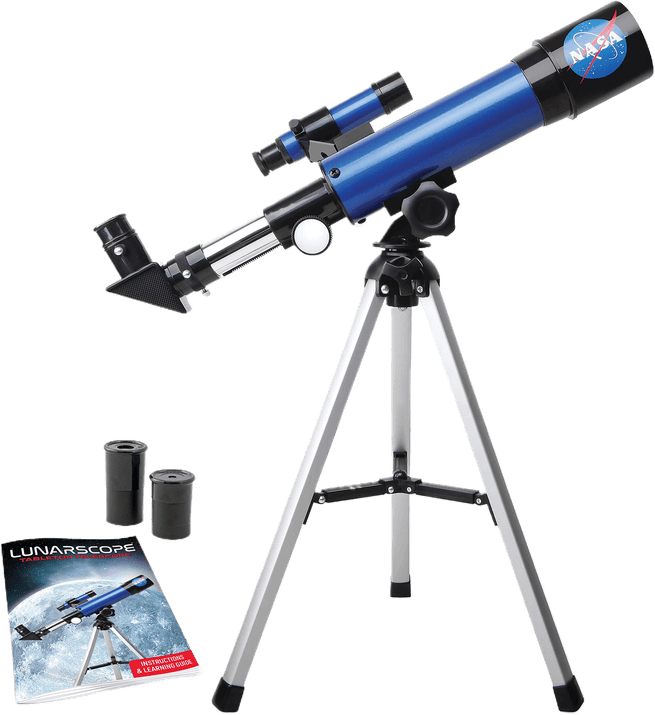
- Super simple and easy to use
- Two eyepieces for a choice of magnification level
- Tabletop tripod for lunar viewing from your house
- Comes with brilliant learning guide
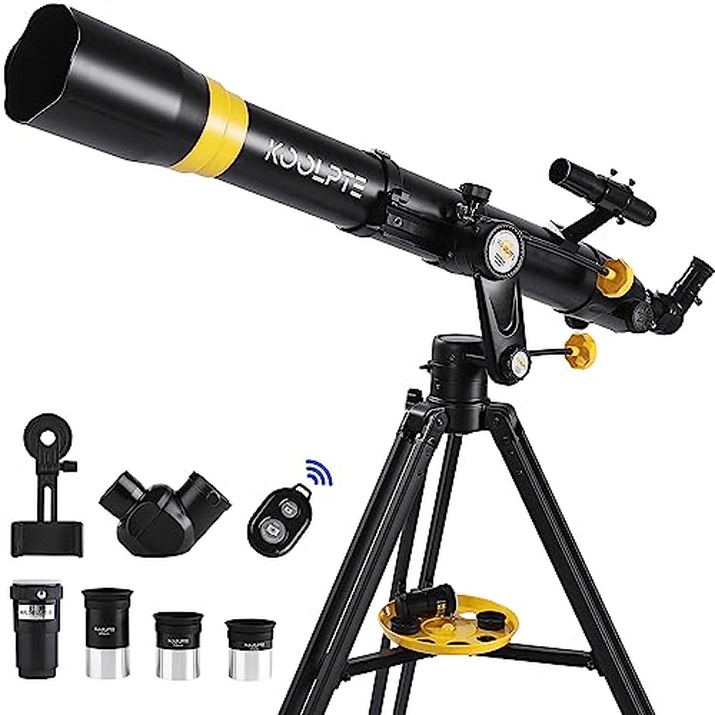
- Three eyepieces and a Barlow lens
- Powerful magnification power with f/10 focal ratio
- Sophisticated Altazimuth mount for precise movements
- Adapter and wireless remote for smartphone astrophotography
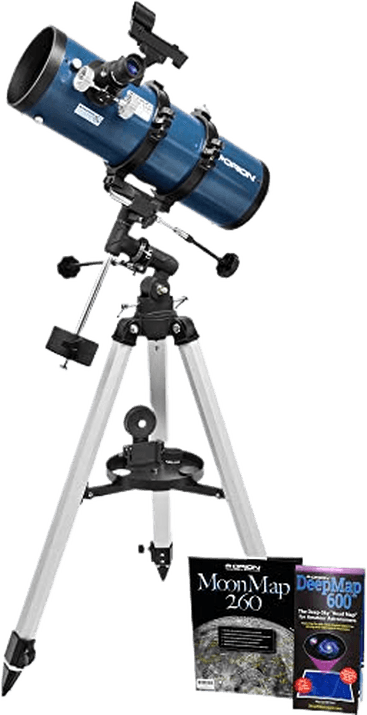
- Increased magnification with the two eyepieces
- Focal ratio f/4 gives you wide-angle view
- Weighted equatorial mount for precision star tracking
- Includes learning materials and a Orion EZ Finder II scope
8 Best Budget Telescopes
This section looks at all the best budget telescopes in more detail. There’s a telescope for all types of amateur astronomers. Whether you’re an adult with a new hobby or a youngster with an insatiable curiosity, we have a telescope for you.
1. Celestron AstroMaster 130EQ Newtonian Telescope

| Brand |
Brand
Celestron
|
| Optical Design |
Optical Design
Reflecting Newtonian
|
| Focal Length |
Focal Length
1000mm
|
| Objective Lens Diameter (Aperture) |
Objective Lens Diameter (Aperture)
114 mm
|
| Focal Ratio |
Focal Ratio
f/8.7
|
| Eye Piece Lens |
Eye Piece Lens
Plossl
|
| Telescopic Mount |
Telescopic Mount
Equatorial
|
| Dimensions |
Dimensions
35 x 19 x 12 inches / 89 x 48.3 x 30.5 cm
|
| Weight |
Weight
17 lb / 7.7 kg
|
| Other Key Features |
Other Key Features
10mm and 20mm eyepieces, StarPointer finderscope, tripod stand, Starry Night astronomy software
|
| Best For |
Best For
Amateurs with a passion for astronomy
|
The Celestron AstroMaster 130EQ Newtonian is the best amateur telescope on the market. It’s too advanced for children. But it’s simple enough for older teens and adults, even with no prior experience. And it gives you stunning glimpses into the sky above!
It’s a Newtonian reflector telescope with a 144 mm mirror to create the image. As a reflecting telescope, you find the eyepiece near the front end of the main barrel.
A focal ratio of f/8.7 gives you a medium-wide field of view and strong magnification. This makes it a great all-rounder. You can view planets, the moon, or double stars. But you can also see star clusters, nebulae, and sections of the Milky Way.
The AstroMaster 130EQ comes with two eyepieces, which increases the versatility. One has a 10mm focal length and the other 20mm. And remember, with eyepieces, a shorter focal length gives you better magnification but a narrower field of view.
With the manual weighted equatorial telescope mount, tracking celestial objects is easy. Setting it up can be a bit tricky for first-timers. But once in position, you can track stars and planets as they move across the sky. Simple turn the knobs to follow your subjects on their axes.
Finding your subject is also easy with the StarPointer red dot finderscope. And the companion “Starry Night” software helps you learn about the night sky.
The Celestron AstroMaster 130EQ comes with a stainless steel tripod. It’s height adjustable. And the central leg stabilizer provides more support and reduces vibrations. It is one of the heavier telescopes on our list. But it’s still portable for trips into the country to avoid light pollution.
2. HEXEUM Portable Astronomical Refracting Telescope

| Brand |
Brand
HEXEUM
|
| Optical Design |
Optical Design
Refracting
|
| Focal Length |
Focal Length
600mm
|
| Objective Lens Diameter (Aperture) |
Objective Lens Diameter (Aperture)
80 mm
|
| Focal Ratio |
Focal Ratio
f/7.5
|
| Eye Piece Lens |
Eye Piece Lens
Plossl
|
| Telescopic Mount |
Telescopic Mount
Altazimuth
|
| Dimensions |
Dimensions
22.8 x 5 x 8.2 inches / 57.9 x 12.7 x 20.8 cm
|
| Weight |
Weight
5.9 lb / 2.6 kg
|
| Other Key Features |
Other Key Features
Barlow eyepiece, remote control, phone mount, carry case
|
| Best For |
Best For
Stargazers looking for a portable and affordable telescope
|
The HEXEUM Portable Astronomical Refracting Telescope is great if you want one you can move around with. It’s lightweight, easy to set up, and gives you a great night sky view. It also comes at a more-than-reasonable price.
It’s a refracting telescope with a 600mm focal length and an objective lens diameter of 80 mm. That gives you a focal ratio of f/7.5. In practical terms, that gives you a fairly wide field of vision. It’s great for viewing the Milky Way and wider sections of the night sky.
It comes with three eyepieces. You have two standard Plossl options with 10mm and 25mm focal lengths, respectively. And you get a Barlow eyepiece that gives you an extra 3x magnification. This helps you view more obscure objects or more detail on the moon’s surface.
The telescope comes with a sturdy aluminum tripod. And on the tripod sits an Altazimuth telescopic mount. It’s a simple mount you have to move manually. This does make it difficult to pinpoint and track night sky objects. But that’s not such an issue with the f/7.5 focal ratio.
Thanks to the smartphone adapter, you can view the telescope’s images on your smartphone. This lets you save astrological images on your phone and share them on social media. It also comes with a handy wireless remote.
The HEXEUM Portable Refracting Telescope is a great choice for young astronomers. Younger kids will need adult supervision. But it’s simple enough for teenagers to use on their own. Adults can have fun with it, too.
3. ToyerBee 300mm Portable Refractor Telescope

| Brand |
Brand
ToyerBee
|
| Optical Design |
Optical Design
Refracting
|
| Focal Length |
Focal Length
300mm
|
| Objective Lens Diameter (Aperture) |
Objective Lens Diameter (Aperture)
70 mm
|
| Focal Ratio |
Focal Ratio
f/4.2
|
| Eye Piece Lens |
Eye Piece Lens
Plossl
|
| Telescopic Mount |
Telescopic Mount
Altazimuth
|
| Dimensions |
Dimensions
11 x 5.5 x 21 inches / 28 x 14 x 53.3 cm
|
| Weight |
Weight
3.5 lb / 1.6 kg
|
| Other Key Features |
Other Key Features
Barlow eyepiece, 6mm and 20mm eyepieces, finder scope, wireless remote, phone adapter
|
| Best For |
Best For
Anyone looking for a super-affordable telescope
|
The ToyerBee 300mm Portable Refractor offers the best value of any telescope on our list. It is one of the more basic models. But it’s child-friendly and portable. And it still gives you a closer look at the cosmos.
Weighing only 3.5 lb (1.6 kg), it’s light for an astronomical telescope. And the overall size isn’t too cumbersome either, making it easy to transport. It’s also easy to set up thanks to the aluminum tripod and Altazimuth mount.
With a f/4.2 focal ratio, you get a wide field of view. That gives you a broad picture of the sky. The magnification isn’t enough for planetary observations. But you get a lovely view of the Milky Way above us.
The image quality is excellent. The objective lens has a multi-layer high transmission coating that maximizes light intake. Of course, keeping the lens clean has to be a top priority to maintain image quality.
The 6mm and 20mm eyepieces give you more viewing flexibility. And using the 6mm option does give you better magnification. The set also includes a Barlow eyepiece that gives a further 3x magnification.
You can grab stunning night sky images on your smartphone thanks to the adapter. Combining the technologies is a great way to build a young person’s enthusiasm for astronomy. And the wireless Bluetooth remote is another handy accessory.
The ToyerBee 300mm Portable Refractor Telescope is easy to use, portable, and affordable. It would make a fantastic gift for a child or teen with their head in the stars. But older hobbyists can have just as much fun with it.
4. Celestron AstroMaster 90AZ Refractor Telescope

| Brand |
Brand
Celestron
|
| Optical Design |
Optical Design
Refracting
|
| Focal Length |
Focal Length
1000mm
|
| Objective Lens Diameter (Aperture) |
Objective Lens Diameter (Aperture)
90 mm
|
| Focal Ratio |
Focal Ratio
f/11
|
| Eye Piece Lens |
Eye Piece Lens
Plossl
|
| Telescopic Mount |
Telescopic Mount
Altazimuth
|
| Dimensions |
Dimensions
16.5 x 6.3 x 4 inches / 42 x 16 x 10.2 cm
|
| Weight |
Weight
16.5 lb / 7.4 kg
|
| Other Key Features |
Other Key Features
10mm and 20mm eyepieces, StarPointer finder scope, tripod
|
| Best For |
Best For
Viewing individual celestial objects
|
The Celestron AstroMaster 90AZ Refractor Telescope gives you incredible magnification. The optical quality is fantastic for viewing celestial objects. And it’s portable and easy to set up. It’s also a mid-priced option compared to others on our list.
With a 1000mm focal length and 90 mm aperture, you get a focal ratio of f/11. That gives you a narrow field of view and a high level of magnification. This is ideal for viewing specific night sky objects like planets or stars. You can also get a detailed glimpse of the surface of the moon.
You get a sturdy aluminum tripod. And there’s a terrific Altazimuth mount. It’s a simple manual mount, which doesn’t give you the greatest accuracy. But it still gives you smooth control over the telescope.
With two eyepieces included, you get more viewing options. The 20mm eyepiece gives you a 50x magnification level. But the 10mm eyepiece gives you an incredible 100x level of magnification.
The StarPointer red dot finder scope helps you find your target and align your telescope. And the optical quality is excellent thanks to the multi-layer coating that boosts light transmission.
The AstroMaster 90AZ Refractor Telescope also comes with Celestron’s “Starry Night” software. It educates and inspires, giving new astronomers all the info they need to get started.
5. Celestron StarSense Explorer DX 102AZ App-Enabled Telescope

| Brand |
Brand
Celestron
|
| Optical Design |
Optical Design
Refracting
|
| Focal Length |
Focal Length
660mm
|
| Objective Lens Diameter (Aperture) |
Objective Lens Diameter (Aperture)
102 mm
|
| Focal Ratio |
Focal Ratio
f/6.5
|
| Eye Piece Lens |
Eye Piece Lens
Kellner
|
| Telescopic Mount |
Telescopic Mount
Altazimuth
|
| Dimensions |
Dimensions
39 x 17 x 9 inches / 99 x 43.2 x 23 cm
|
| Weight |
Weight
14 lb/ 6.4 kg
|
| Other Key Features |
Other Key Features
10mm and 25mm eyepieces, aluminum tripod, smartphone mount, StarSense app
|
| Best For |
Best For
Astronomers who want to integrate their telescope and their smartphone.
|
We have already seen telescopes with smartphone connections. But the Celestron StarSense Explorer DX 102AZ App-Enabled Telescope is the best in that department. It’s perfect for tech-savvy teens or adults.
This telescope gives you a wide-angle view of the sky. The f/6.5 focal ratio allows you to see large swathes of the Milky Way in fantastic detail. And the high-transmission coating gives you an even clearer image.
The StarSense Explorer DX 102AZ lets you capture incredible astrophotography with your smartphone. You can link the two devices with the smartphone adapter. And then, you can use the StarSense app for even better integrated astronomy. It’s compatible with iPhone and Android phones.
StarSense gives you tips and tricks and helps you find constellations, planets, and nebulae in the sky. It also helps you shoot stunning night sky photography with your phone, which you can share on social media.
The telescope has a sophisticated Altazimuth mount. Some Altazimuth mounts are very simple. But this mount gives you dual-axis movement control, making it easier to track your subject. It’s also supported by a strong aluminum tripod with a sturdy leg spreader.
The Celestron StarSense Explorer DX 102AZ is the best option for fully integrating your phone and telescope. It isn’t the lightest telescope. But it is still portable and easy to set up in any location.
6. NASA Luna Telescope for Kids

| Brand |
Brand
NASA
|
| Optical Design |
Optical Design
Refracting
|
| Focal Length |
Focal Length
360mm
|
| Objective Lens Diameter (Aperture) |
Objective Lens Diameter (Aperture)
50 mm
|
| Focal Ratio |
Focal Ratio
f/7.2
|
| Eye Piece Lens |
Eye Piece Lens
Kellner
|
| Telescopic Mount |
Telescopic Mount
Altazimuth
|
| Dimensions |
Dimensions
7 x 4 x 17 inches / 17.8 x 10 x 43.2 cm
|
| Weight |
Weight
3 lb / 1.4 kg
|
| Other Key Features |
Other Key Features
4mm and 20mm eyepieces, tabletop tripod, learning guide
|
| Best For |
Best For
Young kids wanting to learn about the moon and astronomy
|
If your child loves outer space, the NASA Luna Telescope is a fantastic gift. It’s small and portable. And it’s super simple to set up and use. It is limited when it comes to viewing other celestial objects. But it’s a great way to see the moon in all its glory.
With a f/7.2 focal ratio, you get a medium field of view. And thanks to the two eyepieces, you can increase or decrease the magnification level.
The 20mm eyepiece gives you an 18x magnification level. But if you want an even more intense close-up, you can switch to the 4mm one for 90x magnification. You can see intricate details on the moon’s surface.
You get a handy tabletop tripod for mounting the telescope. It lets you view the moon up close from a bedroom window. The Altazimuth mount is simple but allows for controlled movements.
The NASA Luna Telescope comes with a brilliant learning guide. It teaches beginners how to use the telescope. And it’s full of fun facts about the moon, showing you what to look for with the lunar telescope. It’s a fantastic way to get kids started with astronomy!
7. Koolpte 900mm Refracting Telescope

| Brand |
Brand
Koolpte
|
| Optical Design |
Optical Design
Refracting
|
| Focal Length |
Focal Length
900mm
|
| Objective Lens Diameter (Aperture) |
Objective Lens Diameter (Aperture)
90 mm
|
| Focal Ratio |
Focal Ratio
f/10
|
| Eye Piece Lens |
Eye Piece Lens
Plossl
|
| Telescopic Mount |
Telescopic Mount
Altazimuth
|
| Dimensions |
Dimensions
16.7 x 40 x 8.7 inches / 42.4 x 101.6 x 22 cm
|
| Weight |
Weight
20 lb / 9.1 kg
|
| Other Key Features |
Other Key Features
Three eyepieces and Barlow lens, wireless remote, tripod
|
| Best For |
Best For
Viewing deep space objects
|
The Koolpte 900mm Refracting Telescope is one of the most powerful on our list. It is one of the largest and heaviest telescopes we’ve recommended. But it’s the best for viewing individual deep space objects like planets and stars.
It has a large telescope barrel, which gives you a 900mm focal length. And when combined with the 90 mm aperture, you get a focal ratio of f/10. This gives you a narrow field of view but powerful magnification.
The image magnification is also influenced by the three eyepieces you can use. The 20mm gives you 45x, the 10mm gives you 90x, and the 6mm gives you 150x magnification. And if that’s not enough magnification, you can add the 3x Barlow lens.
With one of the best manual Altazimuth mounts, you get excellent telescope control. You can make big movements, turning and tilting the mount. But you can also make precision movements with the vertical and horizontal knobs for star tracking as the Earth turns.
It comes with a smartphone adapter and wireless remote. These accessories make it super easy to take astrophotography pictures with your phone. You can then share your cosmic visions with friends and family online.
Considering the magnification power and accessory pack, the Koolpte Telescope offers incredible value. It might be a bit advanced for kids and young teens. But older hobbyists won’t have a problem getting started with this budget telescope.
8. Orion StarBlast II 4.5 Equatorial Reflector Telescope

| Brand |
Brand
Orion
|
| Optical Design |
Optical Design
Reflecting
|
| Focal Length |
Focal Length
450mm
|
| Objective Lens Diameter (Aperture) |
Objective Lens Diameter (Aperture)
114 mm
|
| Focal Ratio |
Focal Ratio
f/4
|
| Eye Piece Lens |
Eye Piece Lens
Plossl
|
| Telescopic Mount |
Telescopic Mount
Equatorial
|
| Dimensions |
Dimensions
18 x 10 x 54.7 inches / 45.7 x 25.4 x 139 cm
|
| Weight |
Weight
20.7 lb / 9.4 kg
|
| Other Key Features |
Other Key Features
10mm and 25mm eyepieces, Orion EZ Finder II scope, tripod
|
| Best For |
Best For
Viewing star constellations
|
The Orion StarBlast II 4.5 Equatorial Reflector is an incredible telescope for amateur stargazers. It’s a sophisticated piece of astronomical equipment. But it’s also affordable. It also comes with excellent reading materials to help you learn and get started.
It’s a reflecting telescope with a 450mm focal length. And with a 114 mm mirror, you get a focal ratio of f/4. In practice, that means you have a wide-angle view of the stars. So, this telescope is perfect for viewing the Milky Way and star constellations.
You can adjust the level of magnification using the two eyepieces. You have the choice of 10mm and 25mm pieces. And the telescope is armed with an Orion EZ Finder II scope to help you find your target.
It’s equipped with a terrific equatorial mount. And with the counterweights and adjustment knobs, tracking the stars as they move across the sky is easy. It might take a while to set it up. But once you have the knack, you’ll appreciate the precision it gives you.
The adjustable aluminum tripod is strong and stable, with a leg spreader for extra rigidity. That prevents vibrations from reaching the tripod, giving you a better viewing experience.
Amateur stargazers, from teens to octogenarians, will love the Orion StarBlast II 4.5 Telescope. It’s a bit big and cumbersome. But if you don’t need to move it often, that won’t be a problem. It’s a very sophisticated piece of kit at a decent price.
Buyer’s Guide to Find the Best Budget Telescope
Telescopes are complicated pieces of equipment, especially true for beginners. And it’s even true when looking at budget and beginner telescopes.
To help you find the best budget telescope, we’ll explain the different types of telescopes and all the key specifications. This will help you understand the complex terminology and what each spec means in practice.
Main Types of Telescopes
When looking at consumer telescopes, there are two main types we need to look at. These are refracting and reflecting telescopes.
1. Refracting Telescopes
Refracting or refractor telescopes use glass lens elements to channel and focus light to create an image.
These telescopes use two different lenses. You have the objective lens at the front of the telescope. This focuses incoming light, directing it down the telescope barrel. Then you have the eyepiece. This refocuses the light to make it viewable by the human eye.
On a refractor telescope, the eyepiece is situated at the back end of the barrel. It’s on the opposite end of the objective lens.
Refracting telescopes tend to have smaller apertures (objective lens diameters) than reflecting telescopes. So, their magnification power is sometimes limited unless you opt for super-expensive models. But the plus size is that they are usually lighter and more portable.
2. Reflecting Telescopes
Newtonian, Cassegrain, and Dobsonian are all types of reflecting telescopes. Rather than using lenses, reflecting telescopes use mirrors to direct and focus light.
The primary mirror is usually located at the back of the telescope barrel. It reflects light back towards the front, where it uses another mirror to redirect the image into the eyepiece. That’s why eyepieces are usually located near the front end of reflecting telescopes.
Reflector telescopes often appear on lists of affordable telescopes. This is due to the lower cost of mirrors compared to optical lenses. That means you can get larger apertures for less money. They also suffer less from color fringing, giving you better image quality.
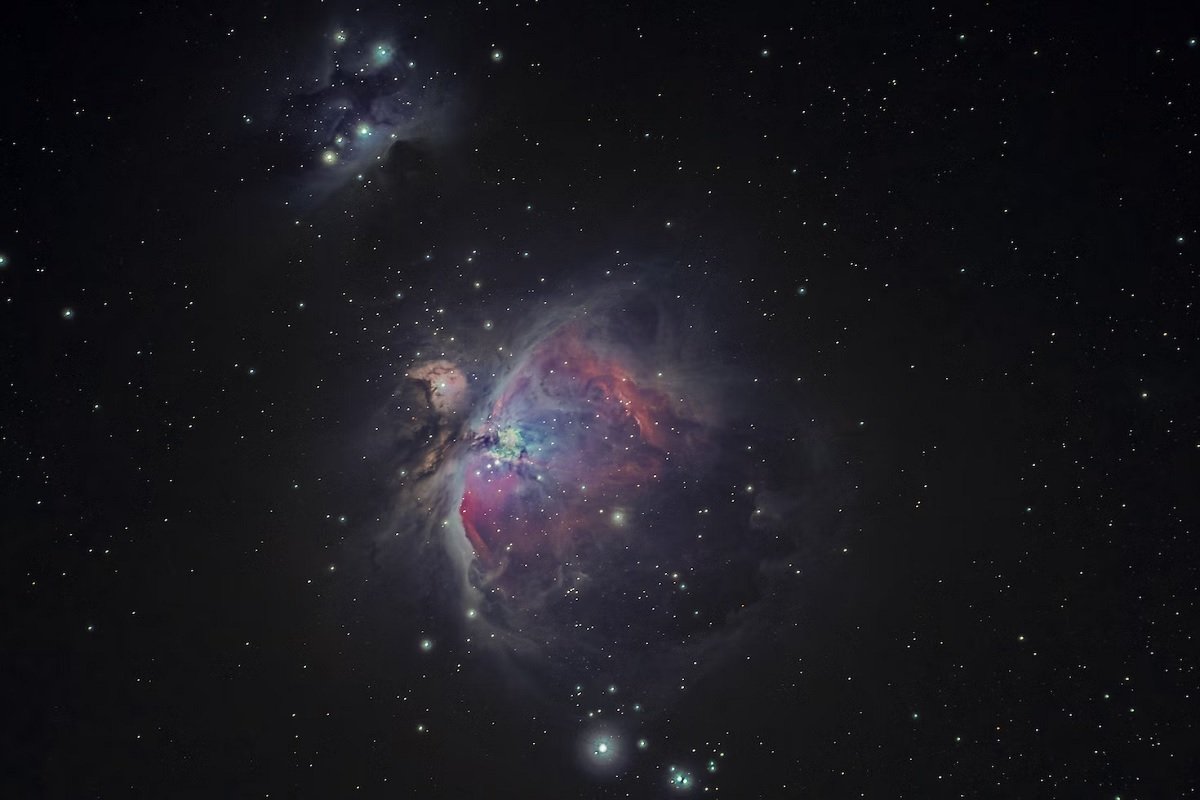
Key Elements of a Telescope
This section breaks down a telescope to identify its main component’s parts. This will give you a better understanding of how telescopes work and their key specifications.
1. Objective Lens
The objective lens is at the front of the telescope, channeling light into the telescope. Larger telescopes, like those at professional observatories, often use mirrors instead of lenses.
But the function is the same. The mirrors channel light through the telescope to create an image we can see with the human eye.
The diameter of the objective lens is an important specification. It’s also referred to as the telescope’s “aperture.” And the diameter measurement tells you how much light the telescope uses.
2. Eyepiece
The main objective lens tube creates an image we can’t see. That’s why we need a separate, smaller lens (or collection of lenses) called the eyepiece.
It’s called the eyepiece because that’s where you place your eye to see the image. It magnifies the image created by the objective lens, letting you see it in all its glory.
Just like the objective lens, the eyepiece has a focal length. With the focal lengths of the objective and eyepiece lenses, you can work out the total magnification of the telescope.
To make this calculation, divide the objective lens focal length by the eyepiece focal length. For example, if you have a 900mm objective lens and a 12 mm eyepiece, the magnification is 75x (900 ÷ 12 = 75). That means an eyepiece with a smaller focal length gives you better magnification.
There are several different types of eyepieces available. Huygenian eyepieces are now obsolete and rarely found on consumer telescopes. But the other types are still worth touching on:
- Kellner: A common type of eyepiece in telescopes at the more affordable end. They offer an apparent field of view of 40 degrees. And it’s an inexpensive eyepiece that still offers high-powered astronomical viewing.
- Plossl: Using four glass elements and a 50-degree field of view, it’s a popular general-purpose eyepiece. It is commonly found on affordable telescopes. And you can use Plossl eyepieces for stargazing and lunar and planetary observation.
- Orthoscopic: Recommended for lunar and planetary astronomy. This is due to its efficient contrast and sharpness. They are losing popularity, but some telescopes still use them.
- Barlow: Barlow lenses decrease the focal length of a standard eyepiece. This increases the level of magnification. Each Barlow lens determines the level of increased magnification.
- Erfle: These eyepieces give you a wide field of view, ranging from 60 to 70 degrees. And with six optical elements, they are great for viewing distant celestial objects, like stars or galaxies.
- Ultrawide: These eyepieces use six to eight elements to give you a wide 85-degree field of view. This is actually wider than a human eye’s field of view, so you need to move your eye around to see the entire image. They can give you incredibly crisp images. But due to their size and amount of glass, they are expensive.
3. Telescope Mounts
All astronomy telescopes need a good mount. Telescopes are very sensitive to vibrations. And too many vibrations stop you from getting a clear view of anything in the night sky. That’s why the best mounts reduce vibrations to an absolute minimum.
Mount have another important role. And that is to give you a system for smooth control over the telescope. Finding specific celestial objects is a precise process. And the mount has to help rather than hinder when you’re looking for star clusters or planets.
There are two main types of telescope mounts—the Altazimuth and the Equatorial mounts. Other mounts do exist, but they are not relevant to this article.
Altazimuth Mount
This is the more basic of the two mount types. You can move it on two axes, altitude (vertical) and azimuth (horizontal), which is why it’s called Altazimuth.
They give you controlled movement for scanning the sky, making it easy to find the objects you’re looking for. They often have knobs for smaller, more precise movements. And some modern mounts are electronic and computer-driven. This gives you more accuracy when finding and tracking objects.
The non-computerized Altazimuth mounts are limited when it comes to deep space viewing. It’s difficult to track stars as the Earth rotates, as it has to be done manually.
Equatorial Mount
This mount is more sophisticated than the Altazimuth mount. It uses counterweights and timers for precision alignment and tracking. Like Altazimuth lenses, you can find computerized equatorial mounts. But even the manual versions are superior.
They take more time to set up. This is because you need to align the mount with the celestial south (not the magnetic south. And you must tilt the telescope back to the same number of degrees as the viewer’s latitude. Once mounted correctly, finding specific objects to view in the night sky is easy.
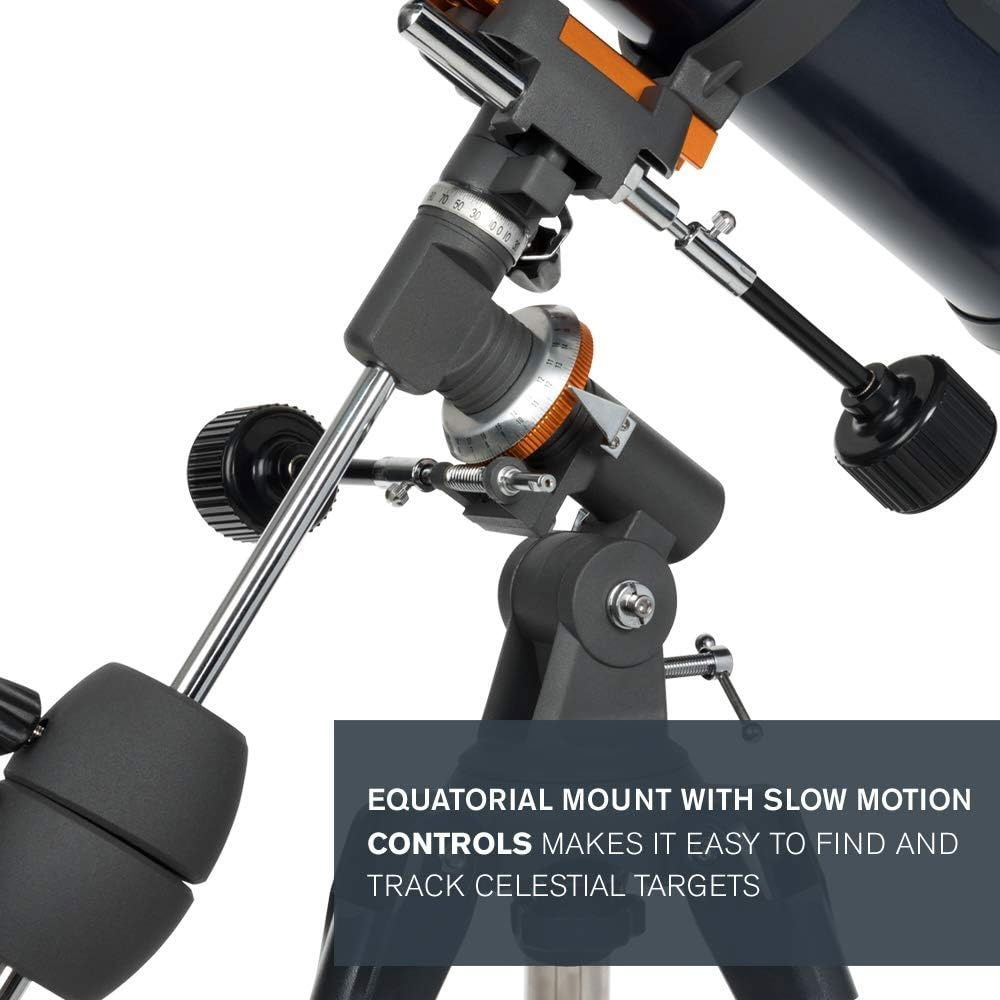
Key Specifications for Telescopes
Some of this terminology will sound familiar if you have some experience with photography and camera lenses. It will help you understand telescopes. But it’s still worth studying more in-depth if you’re unsure. And if you’re a complete beginner, this is the place to start for understanding telescopes.
1. Objective Lens Diameter (Aperture)
The objective lens diameter, or “aperture,” denotes the size of the main lens or mirror of the telescope. That’s different from camera lenses, where the aperture refers to the hole that lets light pass from the lens to the sensor.
On a telescope, the objective lens diameter is the diameter of the light collection area of the telescope’s lens or mirror. And the bigger the diameter, the brighter and more clear your image.
The apertures of telescopes in this article range from 50 to 114 mm. But professional observatories have telescopes with mirrors measured in meters!
Bigger is better when it comes to objective lens diameter. We all want better light-collecting ability for a better view of celestial objects. But with bigger diameters come higher prices. That’s why we’ve looked at telescopes with relatively small apertures.
2. Focal Length
On a camera lens, the focal length is the distance between the focal point and the camera’s sensor or film. But this is slightly different in a telescope.
A telescope’s focal length is the distance between the objective lens (refracting) or mirror (reflecting) and the focal point. The focal point is where the light beams intersect to make a viewable image. This is where the eyepiece is situated on the telescope.
Unlike photography lenses, the focal length doesn’t tell you the level of magnification you get from the lens. With telescopes, the magnification level combines the focal lens of the objective lens and the eyepiece.
We’ve seen the equation in the eyepiece section above. But unlike the eyepieces, a bigger focal length in the main telescope does imply better magnification.
Focal length also has an impact on the size of your telescope. Focal lengths are measured in distance (usually millimeters). So, a larger focal length takes up more physical space.
Our article looks at telescopes with focal lengths ranging from 300mm to 1000mm. You can find telescopes with larger focal lengths. But then you’re leaving the budget section of the telescope department.
3. Focal Ratio
The focal ratio indicates the level of magnification and the field of view of your telescope. Calculate a telescope’s focal ratio by dividing the focal length by the aperture (objective lens diameter).
For example, if the telescope has a focal length of 900mm and an aperture of 90mm, the focal ratio is f/10 (900 ÷ 90 = 10). The focal ratio is denoted as f/ followed by the result of the equation.
This looks like the f-stop scale of a camera aperture. But despite their visual similarity, they do not relate the same information.
A lower focal ratio indicates that the telescope has a wider field of view and a lower level of magnification. Wide-field telescopes have a focal length of f/7 or lower. You’d want a low focal ratio for viewing broad sections of the Milky Way or star clusters.
A higher focal ratio means you have a higher level of magnification and a narrower field of view. An f/10 focal ratio or higher is what you need for viewing planets, double stars, or close-ups of the moon.
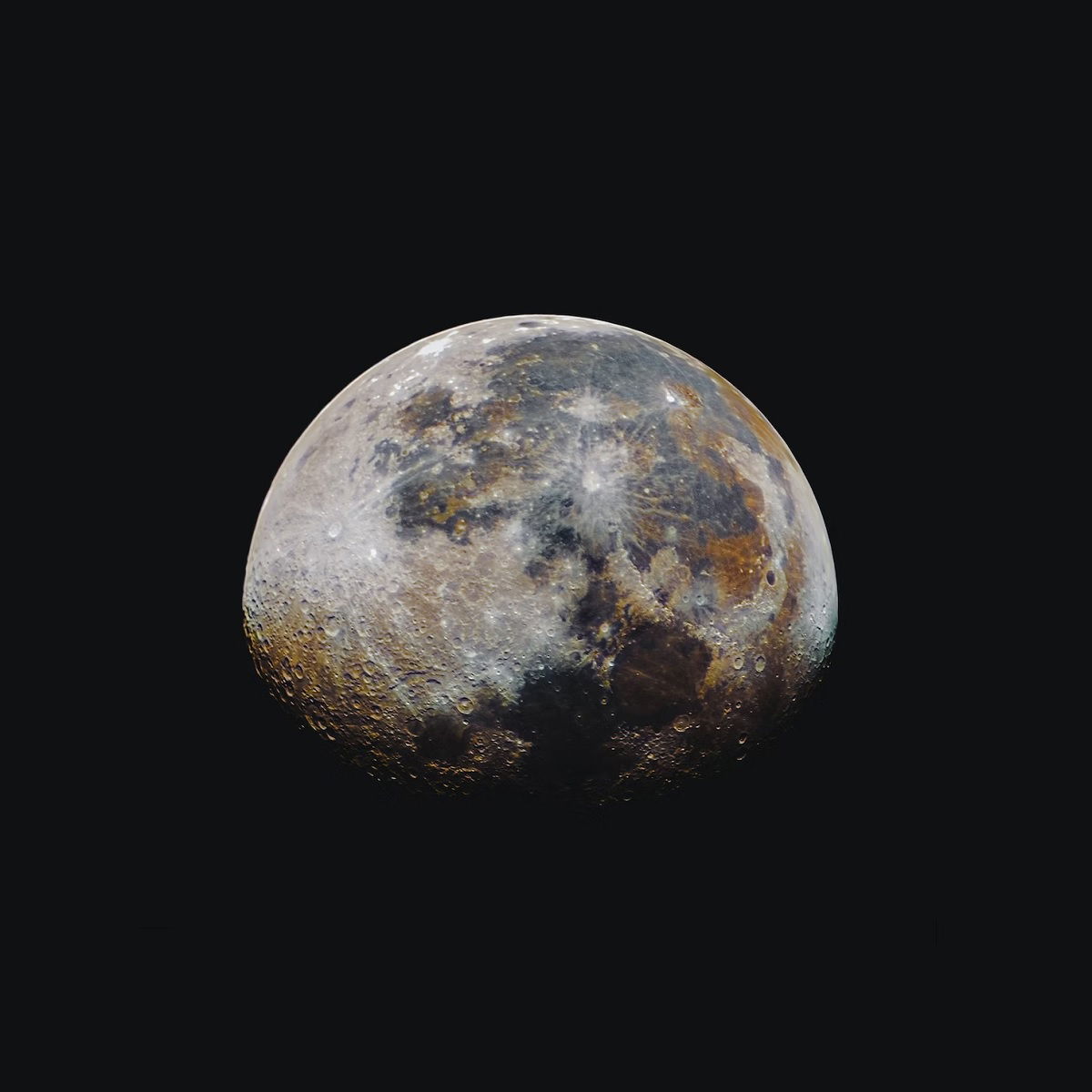
What Are the Best Cameras and Lenses for Astrophotography?
When it comes to cameras, the Canon EOS R6 is our top recommendation. It’s a powerful full-frame mirrorless camera with image stabilization and a wide ISO range. And the Canon RF 15-35mm f/2.8L IS USM is the perfect partner for your Canon R6 on a clear night.
You can also opt for a classic DSLR like the Canon EOS 6D Mark II, a fantastic budget option. Or, if you have a bigger budget, the Sony a7 III gives you incredible image processing power. It gives you stunning night sky images.
If those cameras aren’t what you’re looking for, check out our full article on the best cameras for astrophotography.
Wide-angle lenses are the best for night sky and Milky Way photography. But we have astrophotography lenses for all the top camera brands in our article on the best astrophotography lenses.
Some of the telescopes on our list have smartphone adapters. They let you take astrophotography images with your smartphone. But if you want to get serious about Milky Way photography, you’ll need a camera and lens that are up to the job.
Conclusion: The Best Budget Telescope
The best budget telescopes let you see the stars without spending your life savings. You can get an incredible glimpse of stars, planets, and the moon. You can even capture stunning astrophotography images on your smartphone with adapter telescopes.
We’ve included budget telescopes for amateur astronomers of all ages. But the Celestron AstroMaster 130EQ Newtonian Telescope is our top recommendation. It’s portable and easy to set up. It gives you excellent magnification and image quality. And it delivers excellent value for your money.




